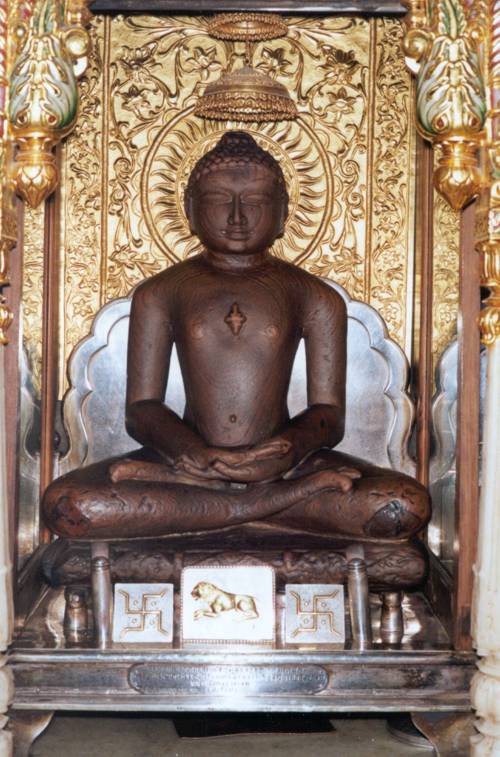
FAQ About Mahavira

Who was Mahavira?
Mahavira, also known as Vardhamana, was the 24th and last Tirthankara of Jainism, a major religion that originated in ancient India. Born in the 6th century BCE, Mahavira is credited with reforming and organizing the principles of Jain Dharma. His teachings emphasized non-violence (ahimsa), truthfulness (satya), non-stealing (asteya), chastity (brahmacharya), and non-possession (aparigraha).

What are the major teachings of Mahavira?
The major teachings of Mahavira include the principles of ahimsa (non-violence), satya (truth), asteya (non-stealing), brahmacharya (celibacy), and aparigraha (non-possession). He advocated for asceticism and self-discipline, emphasizing that liberation and enlightenment can be achieved through strict adherence to these principles, ethical conduct, and meditation.

How did Mahavira contribute to Jainism?
Mahavira played a crucial role in consolidating the philosophical and theological tenets of Jainism. He redefined and established an organized community of followers, imparting a disciplined code of conduct encompassing the five major vows. His emphasis on non-violence and renunciation was foundational in shaping Jain ethics and spirituality.

When and where was Mahavira born?
Mahavira was born in 599 BCE in a place called Kundagrama, which is located in present-day Bihar, India. He was born into a royal family; his father was King Siddhartha of the Ikshvaku dynasty and his mother was Queen Trishala.

Why is Mahavira considered the last Tirthankara?
Mahavira is considered the last Tirthankara because, according to Jain tradition, he was the 24th and final Tirthankara in the current time cycle. Tirthankaras are spiritual teachers who have achieved enlightenment and serve to guide others along the path of righteousness and liberation.

What is the significance of Mahavira's teachings on non-violence?
Mahavira's teachings on non-violence (ahimsa) are of paramount importance in Jain philosophy and have greatly influenced religious thought worldwide. Ahimsa as taught by Mahavira means respecting all living beings and avoiding harm, which extends to thoughts, speech, and actions. This principle is central to Jain ethics and practices.

How does Mahavira's philosophy differ from that of other Indian religions?
Mahavira's philosophy is distinct in its rigorous emphasis on non-violence and detachment from material possessions. Unlike other Indian religions that might permit some form of ritual violence (such as sacrificial practices), Jainism under Mahavira's leadership strictly adheres to ahimsa. Additionally, Jainism uniquely practices extreme forms of asceticism and has a firm belief in the multiplicity of truths (anekantavada).

What is the concept of Tirthankara in Jainism?
In Jainism, a Tirthankara is a spiritual teacher who preaches dharma—the righteous path that leads to liberation. Tirthankaras are disciplined beings who have conquered bodily attachments and desires, achieving Kevala Jnana, or perfect knowledge. They serve as spiritual exemplars, and their teachings form the foundation of the Jain community.

How did Mahavira attain enlightenment?
Mahavira attained enlightenment through intense meditation and severe ascetic practices. According to Jain texts, he practiced self-denial and deep contemplation for twelve and a half years, after which he achieved Kevala Jnana, or omniscience, while meditating under a Sala tree.

What texts are associated with Mahavira's teachings?
The teachings of Mahavira are compiled in the Jain Agamas, which are canonical texts for Jains. These texts, originally passed down orally, encompass discourses and teachings about ethics, philosophy, and conduct critical to Jain practices and beliefs.

How did Mahavira influence modern Jain practices?
Mahavira's influence on modern Jain practices is profound, as his teachings form the core of Jain ethics and spiritual discipline. The five great vows prescribed by him continue to be the fundamental principles guiding Jain monastic and lay life. His stress on non-violence and vegetarianism has also significantly shaped Jain lifestyles and social practices.

What festivals are associated with Mahavira?
Mahavir Jayanti is the most significant festival associated with Mahavira. It celebrates his birth and is observed by Jains with prayers, processions, and community services. Devotional activities include reading scriptures, offering alms, and reiterating his values of non-violence and truth.

What was Mahavira's path to achieving Kevala Jnana?
Mahavira's path to achieving Kevala Jnana, or enlightenment, was marked by renunciation of worldly possessions and an ascetic life. He engaged in prolonged meditation, fasted regularly, and practiced rigorous self-discipline, rejecting any form of comfort or pleasure. This led to his spiritual awakening and ultimate liberation.

What role does meditation play in Mahavira's teachings?
Meditation is a cornerstone of Mahavira's teachings, seen as an essential practice for achieving spiritual clarity and liberation. Through meditation, practitioners can detach themselves from worldly concerns, control their desires, and focus on attaining inner peace and self-realization.

Are there any misconceptions about Mahavira?
One common misconception is that Mahavira founded Jainism. In reality, Jainism predates him, and Mahavira's role was to reform and spread the religion more widely across India. Additionally, while some claim he was contemporary to the Buddha, historical timings show that Mahavira lived earlier.

How do Jains commemorate the life of Mahavira?
Jains commemorate Mahavira's life through various rituals and festivals, with Mahavir Jayanti being the most prominent. Temples hold spiritual discourses and rituals in his honor, emphasizing his teachings. Many Jains engage in meditation, prayer, and community outreach as a tribute to his legacy and values.

What influence did Mahavira have on Indian philosophy?
Mahavira greatly influenced Indian philosophy with his strong emphasis on ahimsa (non-violence) and the notion of relative truths (anekantavada). His ideas not only shaped Jainism but also contributed to broader Indian ethical and philosophical thoughts, influencing other religions and social movements.

How does Mahavira's principle of aparigraha manifest in Jainism?
The principle of aparigraha, or non-possession, manifests in Jainism as a fundamental tenet, advocating for minimizing material desires and possessions. It encourages Jains to live a life of simplicity and generosity, fostering detachment from worldly attachments, which is essential for spiritual progress.

How is Mahavira depicted in art and iconography?
In Jain art and iconography, Mahavira is typically depicted in the lotus position, signifying meditative poise, or in the Kayotsarga posture. His images often show him with a calm, enlightened expression, and distinctive attributes like a lion emblem, representing the spiritual power and majesty of his teachings.

What practices did Mahavira personally follow in his quest for liberation?
In his quest for liberation, Mahavira practiced extreme forms of asceticism. He relinquished all worldly possessions, including clothes, and wandered as a mendicant. He practiced deep meditation and silence, fasted extensively, and embraced hardships to overcome earthly attachments and attain spiritual purity.
